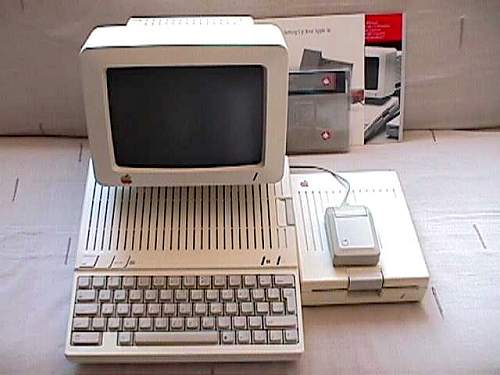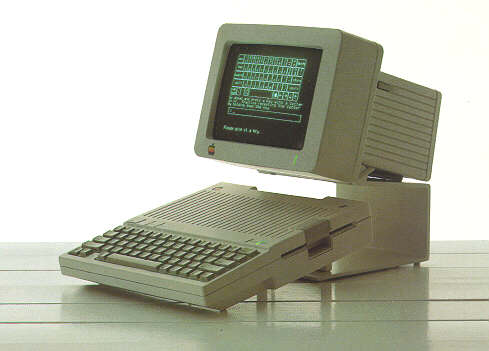Apple IIc
Apple ][c 2c IIc //c - Apple released the Apple IIc in April 1984, billing it as a portable Apple II, because it could be easily carried; however, it lacked battery power and a built-in display. The IIc even sported a carrying handle that folded down to prop the machine up into a typing position.
The Apple IIc was the first Apple II to use the updated 65C02 processor, and featured a built-in 5.25" floppy drive and 128 KB RAM, with a built-in disk controller that could control external drives, composite video (NTSC or PAL), serial interfaces for modem and printer, and a joystick/mouse port. Unlike previous Apple II models, the IIc had no internal expansion slots at all, this being the means by which its compact size was attained.
The final Apple II model was the Apple IIc Plus introduced in 1988. It was the same size and shape as the IIc that came before it, but the 5¼" floppy drive had been replaced with a 3½" drive, the power supply was moved inside (gone was the IIc's "brick on a leash" power supply), and the processor was a fast 4 MHz 65C02 processor that actually ran 8-bit Apple II software faster than the IIGS.
When the Apple IIc was introduced, the informative copy led off with a couple of asterisked sentences:
It weighs less than 8 pounds.*
And costs less than $1,300.**
In tiny type were these "fuller explanations":
* Don't asterisks make you suspicious as all get out? Well, all
this means is that the IIc alone weights 7.5 pounds. The power
pack, monitor, an extra disk drive, a printer and several bricks
will make the IIc weigh more. Our lawyers were concerned that you
might not be able to figure this out for yourself.
** The FTC is concerned about price fixing. You can pay more if
you really want to. Or less.
-- Forbes
Contents
Apple II Forever
The 1984 introduction of the compact Apple IIc, at a boisterous celebration in San Francisco's Moscone Center, is interrupted by a magnitude 6.2 earthquake. The party, called "Apple II Forever," doesn't miss a beat because loyal Apple II users are already shaken up by their belief the company is focusing too much on the Macintosh, even though the Apple II is generating the bulk of sales and profit.
Unfortunately, nothing is forever, not even the Apple II -- although it comes close. On Nov. 15, 1993, more than 16 years after it was introduced, and with over 5 million units shipped, Apple quietly drops the last of the line, the Apple IIe. As a gesture to the faithful, Apple continues offering Apple II technology through an expansion card for some early Mac LC and Performa models.
IIc as a Linux terminal
The Serial card in Apple II computers (except IIgs built-in) have very basic terminal routines built in and will link the screen and keyboard to the serial port for what you are attempting without the need of additional software. Just activate the serial port with a PR#x command, x being the slot the card is in. On the IIc, x=1 if using the printer port, x=2 if using the modem port.
IIc as an OS X terminal
- Connect the Apple II serial cable to a Serial-USB Adaptor
$ cd /dev $ ls tty.* tty.KeySerial1
- Load terminal emulation software on Apple IIc
- Use screen to connect and run getty
$ screen /dev/ttys.KeySerial1
- Ctrl-A, Shift-: and then
exec ::: /usr/libexec/getty std.1200
ADTPro for the IIc
This is a way to transfer data from the old Apple 2c to a modern computer. ADTPro is a SourceForge project.
Note that the original IIc motherboard is not able to operate the serial port accurately at speeds higher than 300 baud, so you have to go really slowly if you have one of those. You can check the revision of your IIc by checking memory location 64447:
- if PRINT PEEK(64427) returns 255, you have an original IIc (ROM revision '255').
- if PRINT PEEK(64427) returns 0, you have an IIc with UniDisk 3.5 inch drive support (ROM revision '0').
- if PRINT PEEK(64427) returns 3, you have an IIc with memory expansion support (ROM revision '3').
- if PRINT PEEK(64427) returns 4, you have an IIc with a modified/fixed version of memory expansion support (ROM revision '4').
- if PRINT PEEK(64427) returns 5, you have an Apple IIc Plus (ROM revision '5').
Contiki for the IIc
The Contiki operating system is an open source, Internet-enabled, operating system designed for tiny systems and runs on a variety systems ranging from the Commodore 64 and the Atari Jaguar to small embedded micro-controllers. Oliver Schmidt and Glenn Jones now bring the Internet and the web to the classic Apple ][ by their Contiki Apple ][ port and Glenn's self-built Apple ][ Ethernet card.
External Pinouts
Joystick -------- 1- GAMESW1 Switch input 1 (sometimes called paddle button 1). 2- +5V total current drain from this pin must not exceed 100mA. 3- GND System ground. 4- Not Used for hand controller. 5- PDL0 hand controller input. Must be connected to a 150K ohm variable resistor connected to +5V. 6- N.C. Not connected. 7- GAMESW0 Switch input 0 (sometimes called paddle button 0). 8- PDL1 hand controller input; must be connected to a 150K ohm variable resistor connected to +5V. 9- Not used with hand controller. DB-15 Video Expansion Connector ------------------------ 1- TEXT Video text signal from TMG; set to inverse of GR, except in double high-resolution mode. 2- 14M 14M master timing signal from the system oscillator. 3- SYNC* Displays horizontal and vertical synchronization signal from IOU pin 39. 4- SEGB Displays vertical counter bit from IOU pin 4; in text mode, indicates second low-order vertical counter; in graphics mode, indicates low-resolution. 5- 1VSOUND One-volt sound signal from pin 5 of the audio hybrid circuit (AUD). 6- LDPS* Video shift-register load enable from pin 12 of TMG. 7- WNDW* Active area display blanking; includes both horizontal and vertical blanking. 8- +12V Regulated +12 volts DC; can drive 300mA. 9- PRAS* RAM row-address strobe from TMG pin 19. 10- GR Graphics mode enable from IOU pin 2. 11- SEROUT* Serialized character generator output from pin 1 of the 74LS166 shift register. 12- NTSC Composite NTSC video signal from VID hybrid chip. 13- GND Ground reference and supply. 14- VIDD7 From 74LS374 video latch; causes half-dot shift high. 15- CREF Color reference signal from TMG pin 3; 3.58 MHz. Note: The signals at the DB-15 on the Apple IIc are not the same as those at the DB-15 end of the Apple III, Apple IIGS, and Macintosh II. Do not attempt to plug a cable intended for one into the other. Several of these signals, such as the 14 MHz, must be buffered within about 4 inches of the back panel connector--preferably inside a container directly connected to the back panel. Printer/Modem port ---------------- The serial ports on the Apple IIc are standard 5 pin DIN, however, they are not labeled as standard DIN. Therefore, when looking at the back of the Apple IIc, the pinouts are as follows: 5 Pin DIN Position Signal Name 1............ 4 O'Clock ... Data Terminal Ready 2............ 5 O'Clock ... Transmit Data 3............ 6 O'Clock ... Signal Ground 4............ 7 O'Clock ... Receive Data 5............ 8 O'Clock ... Data Set Ready PINOUT EXPLANTION Pin 1 (DTR) becomes active when the IIc is ready to go on line. Pin 2 (TD) conveys serial data sent from the IIc. Pin 3 (SG) is used to provide a common ground reference for the electronics in both the IIc and the device it is connected to. Pin 4 (RD) receives serial data sent from the device to the IIc it is connected to. Pin 5 (DSR) is asserted by the device the IIc is connected to when it is ready to go on line. NOTE: The serial ports on an Apple IIc are essentially identical, the pin connections being the same on both. The main difference being that the printer port is pre-configured for 9600 baud and the communication port is preconfigured for 300 baud. The printer port appears to the software as slot 1, the communication port as slot 2. The settings of these ports can be changed with the Apple IIc System Utilities disk. Please see the System Utilities manual for precise details. CHARACTERISTICS AT STARTUP The Apple IIc's ports are configured with keyboard commands instead of DIP switches. After power-up, the IIc sets the printer port to the default configuration given below: - 9600 baud - 8 data bits and no parity - 2 stop bits - 80 chars per line - LF after CR - Command character is CTRL-I - Hardware (DTR flow control protocol) handshake. External Floppy Drive Connector ----------------------- The Apple IIc external disk drive port is a DB-19 connector. The signals available at the port are as follows: 1 - GND 2 - GND 3 - GND 4 - GND 5 - +12V 6 - + 5V 7 - +12V 8 - +12V 9 - /EXTINT 10 - WRPROT 11 - SEEKPH0 12 - SEEKPH1 13 - SEEKPH2 14 - SEEKPH3 15 - /WRREQ 16 - NC 17 - /DR2 18 - RDDATA 19 - WRDATA
reference: Apple Computer Web Site

